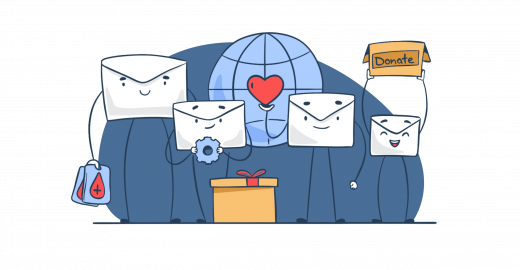33% of American and Canadian donors find email communication the most inspiring for making donations. However, email marketing for nonprofit organizations (NPOs) is very different from the email marketing for-profit organizations (FPOs) usually use.
In this guide, we will take a look at some examples, pros, cons, tools, and more you should know about to help your NPO find and attract new donations through emails!
What is email marketing for nonprofits?
Email marketing messages sent by nonprofits communicate with existing and potential donors, promote new offline and online fundraising events, and help implement new fundraising ideas.
But in contrast to the email marketing we are used to, NPOs send targeted messages and promotional content in their own way:
- An NPO’s email marketing campaigns are not focused on profit but on gaining and retaining supporters for fundraising campaigns.
- The campaigns contain real-life examples to connect with subscribers on an emotional level and show the impact your work has.
- The campaigns’ target audience is made up of people who are interested in helping a cause through a non-profit organization.
- One campaign can have multiple objectives besides just maintaining communication with existing supporters. These objectives include raising awareness about fundraisers, asking for donations, and so on.
Nonprofit email marketing examples
ECPC, through its email marketing, focuses on keeping supporters informed about the organization’s cause.
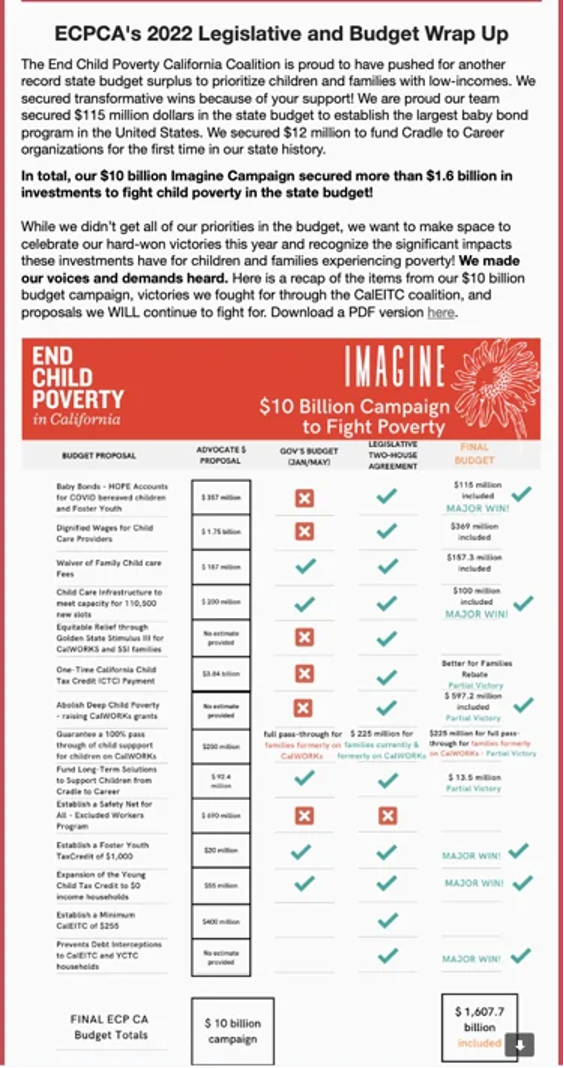
In the newsletter section above, ECPC showed stats in an infographic format to communicate how the Imagine campaign used the collected funds. This is a transparent method of communication and makes the nonprofit look trustworthy to new supporters.
World Wildlife Fund uses storytelling and creates a sense of urgency to motivate readers to complete desired actions.
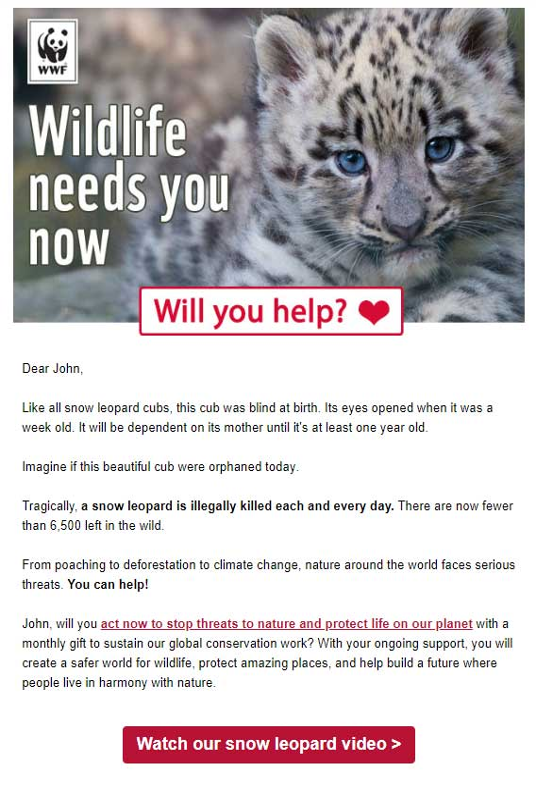
The above email begins with a brief but compelling story about a blind leopard cub. It uses phrases like “You Can Help” and “Safer World for Wildlife” to show how the reader’s contribution can make a real impact. The email also includes a video to retain reader’s attention.
Why should nonprofits use email marketing?
Seeing examples of nonprofit email marketing campaigns might be interesting, but it only becomes useful if you learn something from it. That’s why we’ll now run through all the reasons a nonprofits should use email marketing extracted through the analysis of our ECPC and WWF examples.
The benefits of using email marketing for nonprofits, as demonstrated by ECPC’s campaign, include:
- Effective Communication: Email marketing allows nonprofits to keep supporters informed about their cause, ensuring that they are up to date with the organization’s work, achievements, and challenges.
- Transparent Reporting: Through email newsletters, nonprofits can transparently share statistics and information about how funds are utilized. This transparency builds trust with existing supporters and enhances credibility, which can attract new supporters.
- Conveying Information: Nonprofits can use visually appealing elements like infographics to convey complex information in an easily digestible format, helping supporters better understand the impact of their contributions.
- Attracting New Supporters: Trustworthy communication through email marketing can help nonprofits attract new supporters who are more likely to engage and donate when they believe in the organization’s transparency and effectiveness.
The benefits of using email marketing for nonprofits, as demonstrated in the World Wildlife Fund’s campaign, include:
- Effective Storytelling: Email marketing allows nonprofits to tell powerful stories that resonate emotionally with readers, fostering a deeper connection to the cause.
- Creating Urgency: Email campaigns can effectively create a sense of urgency, encouraging readers to take immediate action to support the organization’s mission.
- Highlighting Impact: Through email marketing, nonprofits can showcase how contributions make a tangible impact, emphasizing the real-world difference readers can make.
- Engagement with Multimedia: The inclusion of videos in emails keeps readers engaged, making it easier to convey the organization’s message and capture their attention effectively.
Nonprofit email marketing statistics
To support our claims on the benefits of email marketing for nonprofits, here is some conclusive data:
- According to M+R Benchmarks, nonprofits gained an average of 685 Facebook fans, 208 Twitter followers, and 160 Instagram followers for every 1000 emails sent in 2022.
- The same M+R Benchmarks report also states that nonprofits sent around 60 emails per subscriber in 2022, 29 of those emails being fundraising appeals.
- 63% of donors in the US and Canada prefer donating online via credit or debit cards.
- 92% of nonprofits send monthly email newsletters.
- 48% of donors find regular email communication to be the most effective method to inspire repeat donations.
Now, onto the costs of using this marketing channel for your nonprofit!
Nonprofit email marketing costs
Although email marketing is a marketing channel that will be easy on your budget, some investments will be necessary, especially if your nonprofit doesn’t have email marketers of its own.
For easier calculation of potential costs, here is an insight into different price models for email marketing software and services, as well as the average cost of hiring email marketing professionals.
Pricing models
| Pricing models | How they work |
| Flat rate pricing | Set price for the usage of an email marketing solutions |
| Tiered pricing | Packages with different features at different price points |
| Per-user pricing | Fixed monthly price per single user |
| Usage-based pricing | Price set according to the usage of an email marketing solution |
Average email marketing professional hiring costs
| Type of professional | USA | UK | Japan |
| In-house | $60,000/year | £36,000/year | ¥5,862,538/year |
| Agency | $250 to $700/email | £250 to £1000/month | $5,000 to $10,000/project |
| Freelancers | $25 to $100/hour | ||
Steps in an effective nonprofit email marketing framework
Your email marketing should be creative and done methodically to bring you closer to achieving your goals. Here is some useful information to help you take that approach.
Step 1 – Craft a purposeful strategy and select the right email marketing solution
To kickstart your nonprofit’s email marketing strategy, employ the SMART (Specific, Measurable, Achievable, Relevant, and Time-Bound) framework to define precise campaign objectives. These could include:
- Fundraising: Determine how much funding you aim to raise through email campaigns, specifying targets and timeframes.
- Volunteer Recruitment: Set measurable goals for recruiting volunteers, indicating the number of volunteers to onboard within a particular timeframe.
- Awareness Building: Define how you will gauge the impact of your email campaigns in terms of increased awareness, such as website traffic or social media engagement.
- Donor Retention: Establish retention targets for current donors, including percentages or numbers to retain over a specific period.
Categorize these goals into short-term and long-term objectives to simplify your planning process. Once your goals are clear, carefully evaluate email marketing software options to choose the one that aligns with your nonprofit’s budget, requirements, and objectives. It’s essential that your chosen solution is scalable and offers seamless integrations with the tools and platforms your organization currently utilizes. This will facilitate a smooth onboarding process and ensure minimal disruption to your existing workflow.
Step 2 – Build your nonprofit email list and ensure data accuracy
To create a robust email list tailored to your nonprofit’s unique mission, it’s essential to gather and validate contacts that are genuinely relevant. Additionally, for effective personalization, you should acquire both first-party and third-party data to gain insights into the interests and preferences of your supporters.
Wondering how to get a substantial number of email addresses? One strategy is to implement strategically timed pop-ups on your website, transforming casual visitors into engaged subscribers. Another effective approach is designing a compelling opt-in form for your landing page, ensuring it’s prominently displayed and optimized for mobile devices, considering that most individuals use smartphones for web browsing.
If you encounter challenges in collecting email addresses for your nonprofit, consider offering valuable lead magnets such as informative reports, eBooks, helpful checklists, or insightful cheat sheets. These incentives can significantly boost your email list growth while providing valuable resources to your supporters.
Step 3 – Craft compelling nonprofit email content and start engaging your supporters
To effectively engage and get more supporters on board through your nonprofit email campaigns, it’s essential to create authentic and emotionally resonant content. Craft your emails with captivating, cause-driven narratives that shed light on your organization’s mission and impact. However, maintain a conversational tone to establish a personal connection with your audience.
Incorporate relevant statistics and figures to substantiate your claims and bolster your message’s credibility. Additionally, have a series of follow-up emails ready to nurture leads and guide your supporters on their journey of involvement. Avoid overwhelming your readers by delivering digestible content in each email, ensuring they can absorb and appreciate the information.
What if you’re not that familiar with your audience? You can use data analysis to see what drives supporter goodwill and to what extent their values match your nonprofit’s cause. The findings from the analysis will also make your content creation process easier as it tells you how passionate certain audience segments are about your cause, thus allowing you to target them properly.
Once the content is done, schedule your emails accordingly in your chosen email marketing software or start sending them right away. But do make sure to use the optimal email sending frequency to maintain regular contact without overwhelming the subscribers. One more thing to keep in mind here: while email marketing is crucial for nonprofits, efficiently managing and organizing your digital assets is equally important. Make sure to educate yourself and discover how this can be achieved with digital asset management solutions for nonprofits.
Step 4 – Analyze results and test different things
To achieve positive results from your nonprofit email marketing, constant improvements and strategic tweaks are a must.
Why? Well, you see, some email campaigns may not resonate with your audience as you expected and might even end up in the spam folder. You’ll know if this is the case by measuring relevant metrics and analyzing your email marketing performance.
You can also run A/B tests to find the most suitable email copy and design variations for each audience segment.
Other testing types you shouldn’t skip include spam score testing, HTML/CSS email template code validation, blacklist presence check, and so on.
Nonprofit email marketing best practices and tips
Okay, now that we have established what your nonprofit email marketing framework should look like, let’s go over some nonprofit email marketing best practices and tips to help you achieve the best results.
Segmentation and targeting
Using a segmented email list ensures the right person gets the right email at the right time. So, categorize your contacts based on their interests, previous donation amount, attended events and webinars, and recorded activity on your website or social media channels. These segments will help you decide the content of your email, call to action buttons (CTA), sending time and frequency, and so on.
Personalization
Personalization is key to effective email marketing. It helps intrigue the recipient and creates a connection with them.
To create accurate audience personas, collect audience data, and then analyze who makes up your email list and what makes them passionate about your cause.
You should also analyze their activity on your website and social media channels. The latter can be captured using social listening tools, while the former is available in your website visits and interactions data.
If you want to take things a step further, here are some additional personalization tips to consider:
- Use eye-catching and personalized email subject lines and headers to boost the email open rate.
- Add data to show how your organization positively impacts causes your recipient believes in.
- Include clear and personalized call-to-action buttons calling for donations.
Connection building
Building a connection through nonprofit email marketing involves crafting compelling messages that resonate with your audience’s values and interests, as well as causing them to feel empathy. By sharing these types of messages, explaining your organization’s mission, and providing opportunities for engagement and support, you can foster a sense of community and a shared commitment to your cause. To further encourage supporter involvement, consider incorporating eSign capabilities in your emails. This allows recipients to seamlessly sign petitions, pledge forms, or donation agreements, enhancing engagement by reducing friction in the commitment process
Automation
Automated email campaigns ensure your audience receives the right emails at the right time without you doing much manually. And if you’re not sure how said automation can be set up, no worries, because chances are your email marketing software, or even CRM, is built to provide it with easy-to-follow instructions.
To make email marketing automation even more effective, you can also follow these tips:
- Set up triggers for sending out personalized welcome email series for new subscribers.
- Implement drip campaigns to nurture email subscribers.
- Implement donation follow-up and thank you emails.
- Use action-based triggers to automate email blasts for general yet important messages about your nonprofit and its activities.
Performance tracking
To know how effective your email marketing campaigns are and make data-driven improvements, tracking performance is a must. Doing so will help you understand what resonates with your audience, identify areas for optimization, and ultimately maximize your impact by increasing engagement and donations.
The most important metric you should be tracking include:
- Average open rate
- Click-through rate
- Response rate
- Conversion rate
- Bounce rate
- Unsubscribe rate
- Revenue per email
- Revenue per subscriber
Debugging and inspecting your nonprofit email marketing campaigns
After you create your email marketing campaigns and think you’re ready to send them, make sure you don’t skip testing them. That way, you’ll be able to catch any errors in the email content, design, links, and other elements.
For the testing, you can use a solution such as Email Testing provided by the Mailtrap Email Delivery platform.
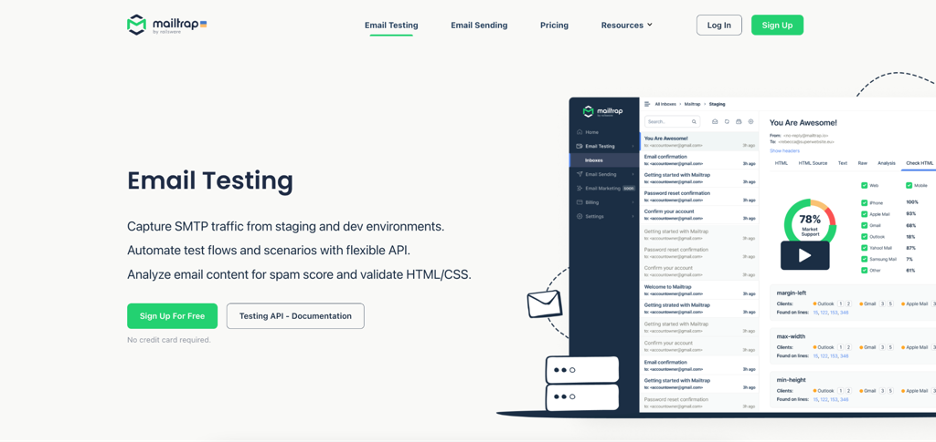
With Email Testing, you can inspect and debug emails before sending them to recipients in environments such as dev and QA. This will allow you to remove any risk of spamming users with testing emails while simultaneously making sure that your emails look as intended when they are sent off.
Some of the most notable features of Mailtrap Email Testing are:
- HTML/CSS check
- Spam score check
- Blacklist reports
- Emails preview on mobile devices and desktop
- Multiple inboxes for different projects and project stages
Email marketing software for nonprofits
Wondering which email marketing services/software to pick for your nonprofit? Here are some popular options:
Mailchimp
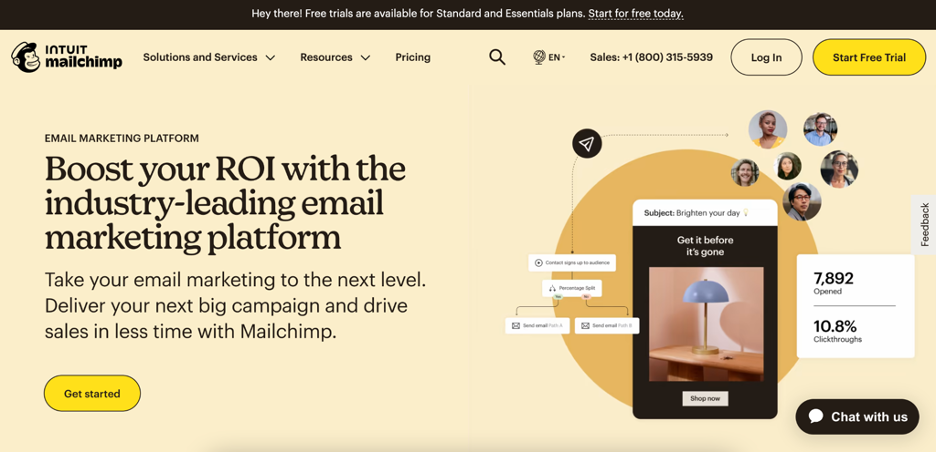
On its website, Mailchimp claims to be the #1 email marketing and automations brand. With it, you gain new ways of winning customers and get recommendations on methods for getting more opens, clicks, and sales.
MailerLite
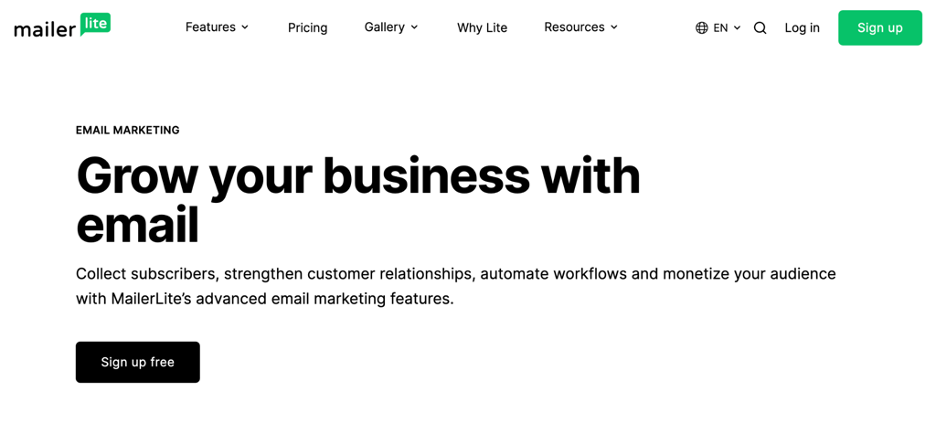
Backed by 24/7 support, MailerLite’s digital marketing tools allow you to grow your audience faster and drive revenue smarter. With its advanced email marketing features, you can collect subscribers, strengthen customer relationships, automate workflows, and monetize your audience.
ConvertKit
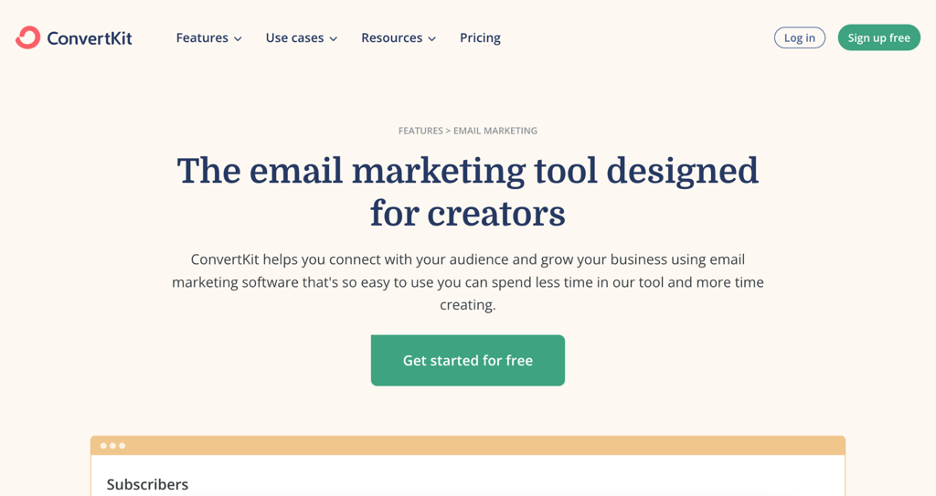
If you’re looking for easy-to-use email marketing software that will help you connect with your audience and grow your business, ConvertKit might be the solution for you. The solution is designed to support your creative process and cut the time needed to build campaigns.
HubSpot
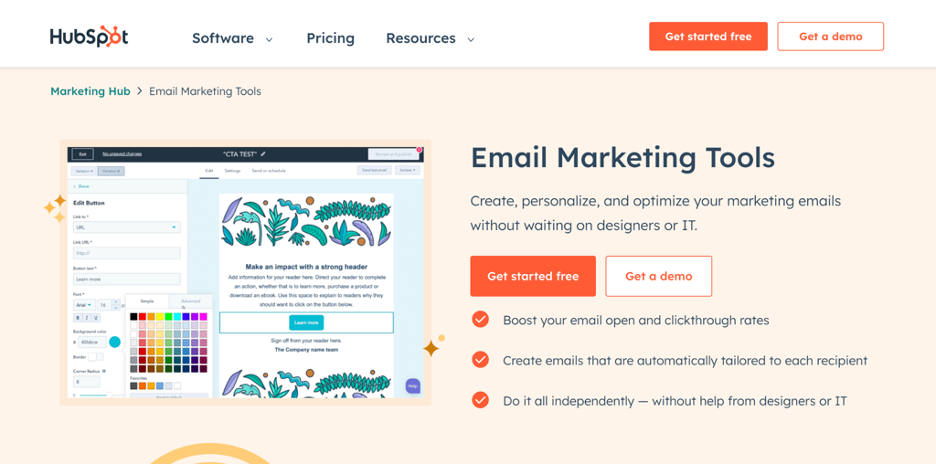
The well-known HubSpot platform comes with email marketing tools enabling its users to create, personalize, and optimize their marketing emails. The marketing emails created using the tools look professional and can be customized according to data gathered from your HubSpot CRM database.
Wrapping Up
The right email marketing for nonprofits strategy can get you more loyal supporters, help forge meaningful connections with those supporters, and allow you to leave a bigger impact. So, use this article as your in-depth guide for mastering nonprofit email marketing and creating a strategy that other marketers would love to copy.
And to avoid making major email marketing mistakes, also give our dedicated YouTube video a watch:

